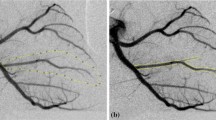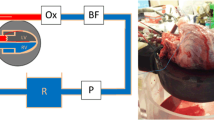Abstract
To evaluate the potential of whole-body CT to detect localized areas of decreased or increased vascularity in coronary arterial walls. We used both microsphere embolization of coronary artery vasa vasorum to generate small areas of hypoperfusion and surrounding hyperperfusion of the arterial wall and diet-induced hypercholesterolemia. As a stimulus for localized angiogenesis, such as occurs in early plaque formation in the coronary arterial wall, microspheres were injected selectively into the LAD coronary artery lumens of anesthetized pigs. Fourteen pigs (acute) then had a segment of their LAD harvested during injection of contrast medium and snap-frozen for subsequent cryo-static micro-CT. An additional thirteen pigs (chronic) were allowed to recover, fed a high cholesterol diet and 3 months later were again anesthetized and a segment of the LAD artery harvested and scanned. The spatial distribution of the contrast agent within the arterial wall was measured in contiguous micro-CT images at right angles to the lumen axis with the area of wall in each cross-sectional image being approximately (0.1 mm)3 in size. In the acute animals there were no localized areas of increased contrast around the hypoperfused embolized perfusion territories in the arterial wall, but in the chronic animals the hypoperfused areas were surrounded by increased contrast. These results suggest that CT might be able to detect localized regions of increased vascularity in the arterial wall as an indicator of early atherosclerotic stimulation of vasa vasorum proliferation.






Similar content being viewed by others

References
Schoenhagen P, Murat Tuzcu E, Stillman AE, Moliterno DJ, Halliburton SS, Kuzmiak SA, Kasper JM, Magyar WA, Lieber ML, Nissen SE, White RD (2003) Non-invasive assessment of plaque morphology and remodeling in mildly stenotic coronary segments: comparison of 16-slice computed tomography and intravascular ultrasound. Coron Artery Dis 14:459–462
Achenbach S, Moselewski F, Ropers D, Ferencik M, Hoffmann U, MacNeill B, Pohle K, Baum U, Anders K, Jang IK, Daniel WG, Brady TJ (2004) Detection of calcified and noncalcified coronary atherosclerotic plaque by contrast-enhanced, submillimeter multidetector spiral computed tomography: a segment-based comparison with intravascular ultrasound. Circulation 109:14–17
Fayad ZA, Fuster V, Nikolaou K, Becker C (2002) Computed tomography and magnetic resonance imaging for noninvasive coronary angiography and plaque imaging: current and potential future concepts. Circulation 106:2026–2034
Marffei E, Palumbo A, Martini C, Tedeschi C, Arcadi T, La Grutta L, Malagò R, Weustink AC, Mollet NR, De Rosa R, Catalano O, Salamone I, Blandino A, Midiri M, Cademartiri F (2011) Computed tomography coronary angiography in asymptomatic patients. Radiologia Medica 116(8):1161–1173
Leber AW, Knez A, Becker A, Becker C, von Ziegler F, Nikolaou K, Rist C, Reiser M, White C, Steinbeck G, Boekstegers P (2004) Accuracy of multidetector spiral computed tomography in identifying and differentiating the composition of coronary atherosclerotic plaques: a comparative study with intracoronary ultrasound. J Am Coll Cardiol 43:1241–1247
Goessl M, Malyar NM, Rosol P, Beighley PE, Ritman EL (2003) Impact of coronary vasa vasorum functional structure on coronary artery vessel wall perfusion distribution. Am J Physiol Heart Circ Physiol 285:H2019–H2026
Herrmann J, Lerman LO, Rodriguez-Porcel M, Holmes DR, Richardson DM, Ritman EL, Lerman A (2001) Coronary vasa vasorum neovascularization precedes epicardial endothelial dysfunction in experimental hypercholesterolemia. Cardiovasc Res 51(4):762–766
Nakata Y, Shionoya S (1970) An experimental study on the vascular lesion caused by obstruction of vasa vasorum (II). Special considerations on deposition of fat into vascular wall. Jpn Circ J 34:1029–1034
Kantor B, Jorgensen SM, Lund PE, Chmelik MS, Reyes DA, Ritman EL (2002) Cryostatic micro-computed tomography imaging of arterial wall perfusion. Scanning 24:186–190
Gössl M, Beighley PE, Malyar NM, Ritman EL (2004) Role of vasa vasorum in transendothelial solute transport in the coronary vessel wall: a study with cryostatic micro-CT. Am J Physiol Heart Circ Physiol 287(5):H2346–H2351
Jorgensen SM, Demirkaya O, Ritman EL (1998) Three-dimensional imaging of vasculature and parenchyma in intact rodent organs with X-ray micro-CT. Am J Physiol Heart Circ Physiol 275:1103–1114
Stary HC, Chandler AB, Glagov S, Guyton JR, Insull W Jr, Rosenfeld ME, Schaffer SA, Schwartz CJ, Wagner WD, Wissler RW (1994) A definition of initial, fatty streak, and intermediate lesions of atherosclerosis. A report from the Committee on Vascular Lesions on the Council on Atherosclerosis, American Heart Association. Arterioscler Thromb 114(5):840–856
Miao C, Chen S, Macedo R, Lai S, Liu K, Li D, Wasserman BA, Vogel-Claussen J, Lima JA, Bluemke DA (2009) Positive remodeling of the coronary arteries detected by magnetic resonance imaging in an asymptomatic population: MESA (Multi-Ethnic Study of Atherosclerosis). J Am Coll Cardiol 53(18):1708–1715
Liu Y-H, Bahn RC, Ritman EL (1992) Dynamic intramyocardial blood volume: evaluation with a radiological opaque marker method. Am J Physiol 263((Heart Circ Physiol 32)):H963–H967
Heistad DD (1986) Blood flow through vasa vasorum in arteries and veins: effect of luminal pO2. Am J Physiol Heart Circ Physiol 250:H434–H442
Kelcz F, Joseph PM, Hilal SK (1979) Noise considerations in dual energy CT scanning. Med Phys 6(5):418–425
Le HQ, Molloi S (2011) Least squares parameter estimate methods for material decomposition with energy discriminating detectors. Med Phys 38(1):245–255
Acknowledgments
This work was supported in part by National Institutes of Health grants, HL065342 and EB000305. We thank Dr. V. Herasevich and Ms. Kay D. Parker for helping to perform some of the animal studies, and Ms. Delories C. Darling for editing and formatting this manuscript.
Conflict of interest
Authors Regina Moritz, Jill L. Anderson, Andrew J. Vercnocke, Robert J. Wentz, and Erik L. Ritman (co-author & corresponding author) declare that they have no conflict of interest.
Author information
Authors and Affiliations
Corresponding author
Appendix
Appendix
The model used to analyze the increased perfusion around an embolized area of the arterial wall assumed that the hypoperfused area was elliptical in shape and is surrounded by a ring of hyper-vascularized tissue. These areas were determined using the directly measured width (along artery lumen axis) of the hypoperfused area (Dx) and the width of the hyper-vascularized ring (th). Dx, the diameter of the perfusion defect in the axial direction, was measured as the distance between the two hyper-vascularization peaks on the perfusion profile along the axial length of the vessel wall, CT (x) is the average CT gray scale value of the vessel wall in the ROI over the arterial wall in one CT slice. Dx and th was measured as the thickness of the hyper-vascularized ring on the profile. The hypoperfused area’s diameter in the arterial circumferential direction, Dy, could not be directly observed, and was calculated using the following measurements: CT(x) is the average CT gray scale value of the vessel wall in the ROI over the arterial wall in one CT slice. Dx and th as defined above, CT1 is CT value of ‘normal’ myocardium, and CT3 is CT value within the hypoperfused area. The hypoperfused and hyperemic tissues and the normal tissue were each assumed to be of uniform CT values. The CT value of the hypoperfused area was assumed to be 0.533/cm, which is the CT value of myocardium when no contrast agent is in the blood stream. The intensity of normal perfused tissue could be observed anywhere outside the boundaries of the hyper-vascularized region. The two remaining unknowns were CT2 (the CT value in the hyperperfused region) and Dy (the circumference diameter of the perfused defect). These were calculated from the perfusion distribution using two specific points of interest—the maximum of the hyperperfused area, and the minimum value in the hypoperfused region as illustrated in Fig. 7.
Upper panel is a schematic of an enface view of an unrolled coronary artery wall. The darker gray elliptical anulus is the hyperemic zone around the hypoperfused zone. The lower panel plots the average circumferential CT gray scale of the total wall CT gray scale value within each contiguous transverse slice along the axis of the arterial lumen
At position x the average CT value along the entire circumference (L) of the arterial wall within a single transluminal section is \( \overline{CT} \)(x).
The equation for the average CT value’s minimum in the hypoperfused region is:
The equation for the maximum value in the hyper-perfused region is:
where
and ΔY0 is the (outer) chord of the hypoperfused area in a cross-section at position x.
At x the vertical chord of the outer edge of the hyperemic rim is ΔY0(x) is the chord at the inner edge of the hyperemic ring. Dx is the measured axial diameter of the hypoperfused area and Dy is the calculated diameter in the circumferential diameter. The hyperemic zone width is th:
-
(a)
Between x locations −(D x /2) − th and −(D x /2) and between (D x /2) and (D x /2) + th: \( \overline{CT} (x) = \left[ {CT_{1} (L(x) - \Updelta Y_{0} (x)) + \,\Updelta Y_{0} (x)(CT_{2} )} \right]/L(x) \)
-
(b)
Between −(D x /2) and (D x /2):
$$ \overline{CT} (x) = \left[ {CT_{1} (L(x) - \Updelta Y_{0} (x)) + (\Updelta Y_{0} (x) - \Updelta Y_{i} (x))(CT_{2} ) + \Updelta Y_{i} (x)*CT_{3} } \right]/L(x) $$ -
(c)
As the area of the elliptical hypoperfused region = ΣΔy(x)
then Dy = ΣΔy(x)/(π·Dx)
$$ \begin{aligned} \, \Updelta Y_{0} (x) & = \sqrt {\left[ {1 - \frac{{x^{2} }}{{\left( {\left( {D_{x} + 2th} \right)/2} \right)^{2} }}} \right]\left[ {\left( {D_{y} + 2th} \right)/2} \right]} \\ \, \Updelta Y_{i} (x) & = \sqrt {\left[ {1 - \frac{{x^{2} }}{{\left( {D_{x} /2} \right)^{2} }}} \right]\left[ {\left( {D_{y} /2} \right)} \right]} \\ \end{aligned} $$
Noise in the perfusion profile as well as deviations of the hypoperfused area’s shape from elliptical made it difficult to use an analytical solution to calculate the CT2 and Dy variables. Hence, we adjusted an estimate of the values of Dy and CT2 empirically by overlaying a plot of the model onto the perfusion profile and then adjusting the variables until the model best fit to the perfusion profile such that the modeled profile in the regions around \( \overline{\text{CT}}_{\hbox{min} } \) and \( \overline{\text{CT}}_{ \hbox{max} } \).
Once the best fit values of Dy was established:
The area of the hypoperfused region, Ahypo = (π/4)Dy * Dx and
The area of the hyperperfused region, Ahyper = (π/4)[(Dx + 2th)(Dy + 2th) − Ahypo)].
Rights and permissions
About this article
Cite this article
Moritz, R., Anderson, J.L., Vercnocke, A.J. et al. Changes in CT angiographic opacification of porcine coronary artery wall with patchy altered flow in vasa vasorum. Int J Cardiovasc Imaging 29, 1325–1333 (2013). https://doi.org/10.1007/s10554-013-0198-6
Received:
Accepted:
Published:
Issue Date:
DOI: https://doi.org/10.1007/s10554-013-0198-6




